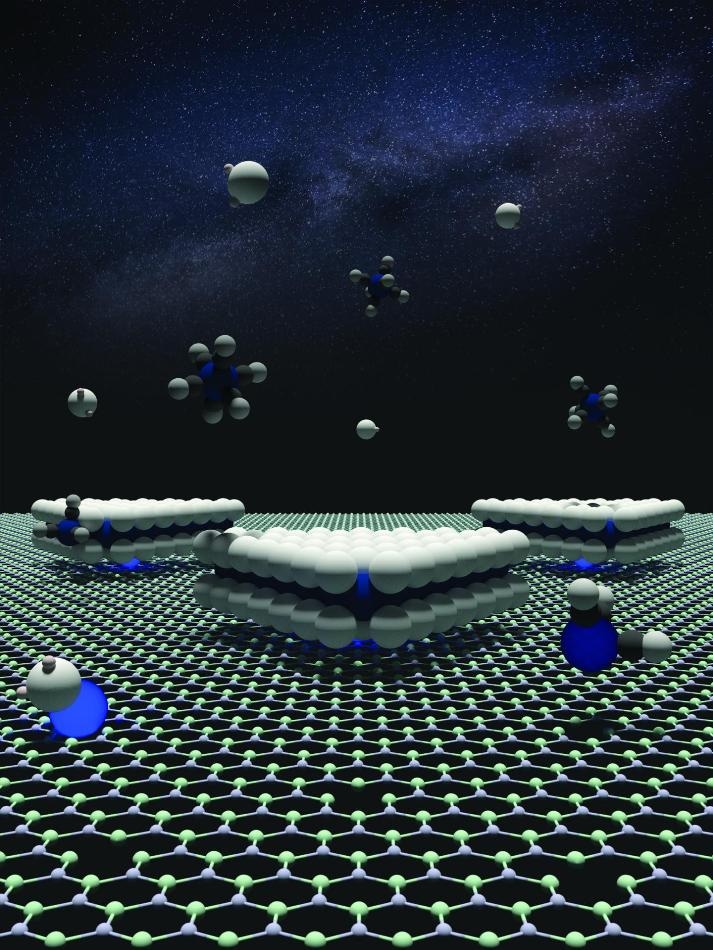May 10 2019
Despite making huge attempts, it is a challenge to develop 2D materials big enough to be used in electronics. However, currently, Penn State scientists have found out a technique for enhancing the quality of a group of 2D materials, with the capability to realize wafer-scale development in the future.
 Graphic showing a boron nitride surface with tungsten atoms anchoring triangular domains illustrating defect control of the orientation. (Image credit: Xiaotian Zhang/Penn State)
Graphic showing a boron nitride surface with tungsten atoms anchoring triangular domains illustrating defect control of the orientation. (Image credit: Xiaotian Zhang/Penn State)
The field of 2D materials with remarkable properties has seen a boom over the last 15 years since Konstantin Novoselov and Andre Geim pulled off a single atomic layer of carbon atoms from bulk graphene with the help of a simple adhesive tape. Despite conducting a significant amount of science on these tiny fragments of graphene, it is challenging to grow industrial-sized layers.
Among the materials visualized for next-generation electronics, a class of semiconductors known as transition metal dichalcogenides is at the vanguard. TMDs have the thickness of only a few atoms; however, they are very efficient at radiating light, which makes them suitable candidates for optoelectronics such as photodetectors, single-photon emitters, or light-emitting diodes.
Our ultimate goal is to make monolayer films of tungsten diselenide or molybdenum disulfide sheets, and to deposit them using chemical vapor deposition in such a way that we get a perfect single crystal layer over an entire wafer.
Joan Redwing, Professor, Materials Science and Electronics, Penn State
Redwing is also the director of Penn State’s 2D Crystal Consortium, a National Science Foundation Materials Innovation Platform.
The issue arises from the way atoms arrange themselves when they are deposited on a standard substrate, for example, sapphire. Due to the crystal structure of TMDs, they form triangles when they start to disperse across the substrate. It is possible to align the triangles in opposite directions, with equal probability. When they hit and combine together to create a continuous sheet, the boundary they create is like a great deficiency that radically decreases the optical and electronic properties of the crystal.
“When the charge carriers, such as electrons or holes, encounter this defect, called an inversion domain boundary, they can scatter,” Redwing stated. “This has been a classic problem with TMD growth.”
In the latest publications in the journals ACS Nano and Physical Review B, scientists in Penn State’s Departments of Materials Science and Engineering, Physics, Chemistry, and Engineering Science and Mechanics demonstrate that if the TMDs are cultured on a surface of hexagonal boron nitride, ≥85% will orient in the same direction.
Vin Crespi, renowned professor of physics, materials science and engineering, and chemistry, and his team ran simulations to elucidate why this took place. They discovered that gaps in the hexagonal boron nitride surface, created due to the missing of a boron or nitrogen atom, could entrap a metal atom—molybdenum or tungsten—and aid in aligning the triangles in the desired direction. The enhanced material exhibited increased photoluminescence emission and higher electron mobility one order of magnitude higher than 2D TMDs cultured on sapphire.
Our next step is to develop a process to grow hexagonal boron nitride across a wafer scale. That’s what we’re working on now. It’s difficult to control defects and to grow a single crystal layer across a large surface. Many groups are working on this.
Joan Redwing, Professor, Materials Science and Electronics, Penn State
This research was conducted in the facilities of the 2D Crystal Consortium Materials Innovation Platform, a National Science Foundation-supported national-user facility aimed at advancing the production of 2D materials. The user facility can be accessed by all U.S. universities, government laboratories, and industries.
Contributing authors on the ACS Nano paper, titled “Defect-controlled Nucleation and Orientation of WSe2 on hBN: A Route to Single-crystal Epitaxial Monolayers,” include Xiaotian Zhang and Fu Zhang, graduate students at the time the study was carried out; and professors Nasim Alem, Mauricio Terrones, and Saptarshi Das, as well as Crespi and Redwing.
Contributing authors on the Physical Review B paper, titled “Full Orientation of Epitaxial MoS2 on hBN Assisted by Substrate Defects,” include lead authors Fu Zhang, research assistant professor, and recent doctoral graduate Yuanxi Wang.